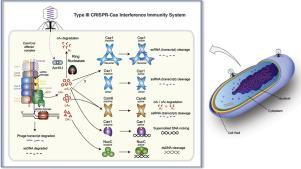Current Opinion in Structural Biology ( IF 6.1 ) Pub Date : 2020-07-23 , DOI: 10.1016/j.sbi.2020.06.010 Rafael Molina 1 , Nicholas Sofos 1 , Guillermo Montoya 1

|
CRISPR loci and CRISPR-associated (Cas) genes encode an adaptive immune system that protects many bacterial and almost all archaea against invasive genetic elements from bacteriophages and plasmids. Several classes of CRISPR systems have been characterized, of which the type III CRISPR systems exhibit the most unique functions. Members of type III cleave both RNA and DNA not only through their corresponding effector complexes but also by CRISPR-Cas associated proteins activated by second messengers produced by those effector complexes. Furthermore, the recent discovery of second messenger degrading proteins called ring nucleases adds an extra regulatory layer to fine-tune these immunity systems. Here, we review the defense mechanisms that govern type III CRISPR interference immunity systems focusing on the structural information available.
中文翻译:

CRISPR-Cas III 型原核防御系统的结构基础。
CRISPR 基因座和 CRISPR 相关 (Cas) 基因编码一种适应性免疫系统,可保护许多细菌和几乎所有古细菌免受来自噬菌体和质粒的侵入性遗传元件的侵害。已经表征了几类 CRISPR 系统,其中 III 型 CRISPR 系统表现出最独特的功能。III 型成员不仅通过其相应的效应复合物切割 RNA 和 DNA,还通过由这些效应复合物产生的第二信使激活的 CRISPR-Cas 相关蛋白切割 RNA 和 DNA。此外,最近发现的称为环核酸酶的第二信使降解蛋白增加了一个额外的调节层来微调这些免疫系统。在这里,我们回顾了控制 III 型 CRISPR 抗干扰系统的防御机制,重点关注可用的结构信息。











































 京公网安备 11010802027423号
京公网安备 11010802027423号